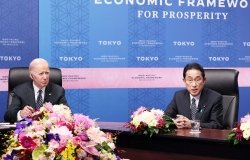Efforts in Moving Towards a Low Carbon Future: China's Energy Conservation and Renewable Energy Laws
Wang Mingyuan, executive director of the Center for Environmental, Natural Resources & Energy Law at the Tsinghua University Law School, discusses the content of the energy conservation law, which was amended in 2007.
Overview
Coal outputs surge in China in the month of February in the wake of a major winter storm that resulted in the loss of power supply to 17 provinces and cities, and a gap between supply and demand of electricity of 40 million kilowatts at peak time. The storms refocused global attention on China's dirty power sector, with the World Bank and OECD reporting 750,000 deaths from pollution induced respiratory diseases and cancer rates rising across the country. It is in the this context that China's amended energy conservation law will be released in April, in time to help meet the targets of the 11th Five-Year Plan, which requires a 20 percent reduction in energy consumption per unit of GDP and a 10 percent emissions reduction.
Over the past few years, the Chinese government has promulgated a number of progressive energy laws that lay out an important legal framework to support energy efficiency and renewable energy projects and development. At this meeting of the China Environment Forum, Wang Mingyuan, executive director of the Center for Environmental, Natural Resources & Energy Law at the Tsinghua University Law School, who was involved in drafting some of these laws, discussed the content in the energy conservation law, which was amended in 2007.
Nowhere is China's transition from planned to market economy more visible than in China's energy sector—one of the most heavily planned sectors, in which energy conservation is a relatively unexplored tool for saving money and protecting the environment. The energy law that has been in force since 1997 was clearly based on planned economy governance with consumption controlled mainly through quotas and prohibitions against new facilities with outdated energy consuming equipment. The historical context of the 1997 law also shaped the law's structure. Specifically, in 1997 around the time of the Asian financial crisis while there were fears throughout the region of economic downturn, China was experiencing an excess of coal and energy for industry. In this context, the 1997 Energy Conservation Law, while sound it its priorities failed to achieve its goals of increasing domestic research and development in energy conserving technologies and of making industry more energy efficient.
The Failure of the Energy Conservation Law
The primarily failure of the 1997 Energy Conservation Law was that it was extremely short and contains little enforcement strategy and no legal or market-based incentive structure or clear targets. Further, the 1997 Energy Conservation Law was clearly not designed for the levels and distribution of energy use in today's China. For example, at the time of its promulgation, China was predicted to double its coal use by 2010. That marker was reached in 2007. Moreover, at that time there were less than 500,000 cars in Beijing so the transportation sector was excluded from the original law. Today there are about 3 million, with 1,000 new cars on the road everyday in that city alone. Additionally, as the economic system changed to become more free market, many of the government bodies at all levels that were in charge of enforcing the energy conservation law's mandate were dissolved or consolidated, resulting in fewer responsible authorities.
The last and most challenging reason for the original energy conservation law's failure is a lack of understanding among local officials and enterprise leaders of the true cost of energy and the advantages of conserving. Although the law stipulates funding for research and development and investment in this sector, in reality there were limited funds and poorly executed energy conservation projects, indicating how this work was a low priority for researchers and enterprises. This financial shortcoming, combined with standards that were easy to meet at current technology levels, has resulted in a lag in the development of local energy efficient technology in China.
The Amended Law
The amended Energy Conservation Law goes into effect in April 2008. Importantly, it declares that energy conservation is a national priority, whereas the original law focused on power supply and availability. In a bid to create accountability, the new amended law includes specific reporting procedures, in which all local governments report to the State Council annually on their energy conservation work and achievements. It also places the supervision and administration of the law in the hands of an energy conservation administrative department at all levels of government. To better reflect today's energy consumption in China, the law adds the sectors of transportation, construction, and public institutions.
Most importantly, an entirely new chapter was also added to the law—Chapter 5, entitled Incentive Measures—to include market-based enforcement solutions to the law. This chapter introduces energy conservation funds at the national and local level, and includes tax and financial subsidies for energy conserving products, and loans for large-scale energy conservation projects. It also includes government procurement measures, although professor Wang was not certain that there would be penalties for non-compliance. Pricing of energy is also introduced in this chapter. Wang admits that energy pricing in China remains lower than the real costs, but the cost of energy is slowly rising and energy shortages are increasingly common—both important incentives for industry. Although the policies outlined in this new law are relatively vague, other ministries will set clearer targets, specifically the National Development and Reform Commission, Ministry of Construction, Ministry of Agriculture, Ministry of Transportation, the bureau for tax and others.
Conclusions
The question of whether this law will correct the failings of the previous law remain. Wang stressed his optimism about improved enforcement. Unlike the United States, energy policy in China is developing with very little civil society input. The first step of domestic nongovernmental organizations moving towards the politically sensitive area of energy is Ma Jun—founder and director of the NGO Institute for Public and Environmental Affairs—who publishes data on water and now air emissions across the country. Ma Jun uses primarily government data, nevertheless his publication of information on the highest pollutant emitters is important to the participation of citizens in energy conservation. The primary nongovernmental groups working in China on energy are international groups, often with a central focus on global climate change. Their efforts, such as the Energy Foundation and the Natural Resources Defense Council, both of whom have worked with Wang, have influenced the development of energy conservation policy in China.
Drafted by Linden Ellis.
Speaker
Wang Mingyuan
Hosted By

China Environment Forum
Since 1997, the China Environment Forum's mission has been to forge US-China cooperation on energy, environment, and sustainable development challenges. We play a unique nonpartisan role in creating multi-stakeholder dialogues around these issues. Read more

Environmental Change and Security Program
The Environmental Change and Security Program (ECSP) explores the connections between environmental change, health, and population dynamics and their links to conflict, human insecurity, and foreign policy. Read more
Thank you for your interest in this event. Please send any feedback or questions to our Events staff.










